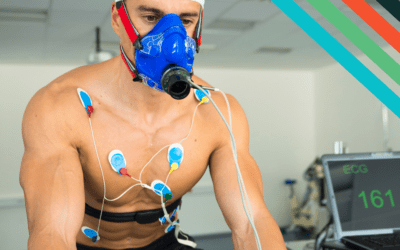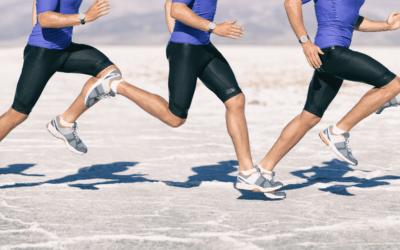Introduction
“Stretching” has become somewhat of a dirty word in athletics. These days, the general opinion seems to be that stretching is useless and can even be harmful.
On the other hand – stretching amongst the general population has become trendy, popular, and in some cases the main form of exercise in people’s week. With the advent of the modern yoga class, many people are turning to stretching/relaxation/meditation classes as their main forms of movement throughout the week.
Between these two extremes is the professional trainers and therapists, who usually sit somewhere in the middle of these types of debates. Most of us do see some benefit to mobility and flexibility, but know that it can be taken too far – leading in some cases to over-stretching, straining, muscle tears, or joint damage.
With the recent advent of tools like PAILs/RAILS – a method popularized by Functional Range Conditioning – we need to know how this tool fits into our tool box, and where and when (if ever) it should be used. From there, we can prescribe effectively.
What is range of motion (ROM)?
Human movement is dependent on the amount of range of motion (ROM) available in joints. In general, ROM may be limited by 2 anatomical entities: joints and muscles. Muscle provides both passive and active tension: passive muscle tension is dependent on structural properties of the muscle and surrounding fascia, while dynamic muscle contraction provides active tension. Structurally, muscle has viscoelastic (fluid+elastic) properties that provide passive tension. Active tension results from the neuro-reflexive properties of muscle, specifically, motor neurons that activate the muscle.
Obviously, there are many factors and reasons for reduced joint ROM, only one of which is muscular tightness. Muscle “tightness” results from an increase in tension from active or passive mechanisms. Passively, muscles can become shortened through postural adaptation or scarring; actively, muscles can become shorter due to spasm or contraction. Regardless of the cause, tightness limits range of motion and may create a muscle imbalance (Page et al, 2012).
Most people can feel intuitively when the tightness in their joints and muscles has become a problem. Not only is it uncomfortable, but it limits what people are able to do in their day-to-day activities. Athletes feel this all-too-commonly as well. Ignoring ankle flexibility for too long, and then attempting a deep squat, leaves many feeling like they’ve gotten a wake-up call about their need for more mobility.
As we age, either to due some of the adaptations or habits that we adopt over time (more scarring in the fascia, loss of motor units, injuries, less hydration), there tends to be a loss of flexibility and mobility. The perfect example of this is comparing a 100m sprinter in their 20’s or 30’s to a master’s level sprinter. The range of motion in the hips, spine, and most joints, has decreased significantly.
https://www.youtube.com/watch?v=2O7K-8G2nwU&t=308s
https://www.youtube.com/watch?v=zv9OneDrB4Q
But why does all of this matter? Clinicians and strength and conditioning practitioners who work with a range of clients from elite athletes to average Joe must choose the appropriate intervention or technique to improve muscle tension based on the cause of the tightness, and are tasked with improving ROM for people’s varying goals. Let’s dive deeper.
Definitions
What is stretching, mobility and flexibility?
Stretching generally focuses on increasing the length of a musculotendinous unit, in essence increasing the distance between a muscle’s origin and insertion. Inevitably, stretching of muscle applies tension to other structures such as the joint capsule and fascia, which are made up of different tissue than muscle with different bio-mechanical properties. Stretching can be dynamic or passive.
Mobility, by contrast to stretching, refers to the relative ease and freedom of movement in all of its forms, and is considered central to healthy aging, according to the literature (Satarino et al, 2012). Many practitioners refer to flexibility as the “passive range of motion” that a joint can attain, whereas mobility is typically referred to as the “active range of motion” that a joint can attain. The difference would be easily distinguishable when asking you to prop your hamstring on a chair and stretch your torso to your thigh as far as possible. This would be your “passive flexibility” in your hamstring and hip joint. Then, with the leg still propped on the chair, standing up tall and trying to lift your foot into the air with active quad tension, would reveal how much active hamstring flexibility (along with quad strength in this example) you might have.
You could repeat the same experiment laying on your back and having someone stretch one of your hamstrings. How far can they stretch your leg without bending your knee? Ok, now doing the stretch on your own, how far can you get your hamstring to stretch by pulling that leg towards your face? If there’s a gap between the two, it’s said you have a gap in your mobility or active ROM compared to your passive ROM.
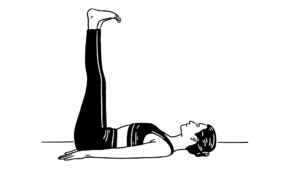
So what is FRC?
Recently, there has been an explosion of practitioners using the Function Range Conditioning method (FRC) for gaining mobility. I am not exempt from this group, as I have taken both the primer weekend course and the full Level 1 FRC courses back in 2013 in order to gain a more broad tool box for use with athletes and clients on how to minimize pain and optimize function.
Although there are many criticisms of the FRC method, there are many things that they are contributing to the industry, including a more detailed assessment piece, and a simple way of understanding where strength and conditioning coaches or therapy practitioners should perhaps be spending more of their time looking.
You’ll hear a lot of practitioners state that “stretching is useless” after taking courses like those offered by FRC. With the rhetoric that stretching “does nothing” or that “you can gain all the range you need from strength training”, it has left people confused! So – what is this new stretching method proposed by FRC, and how is it different from traditional stretching? To better understand things, let’s dive into the physiology.
Dive into muscle physiology
To dive deeper let’s do a quick lesson in muscle physiology. First, how does a muscle contract?
A muscle is made up of many individual muscle fibres, depicted in the picture below as long tubules that are either red purple or blue. (While they do have some colour differences in real life, they aren’t this pronounced – just coloured in this way here for clarity).
Many muscle fibres are packaged inside each of these tubules are all the same type of muscle fibre.
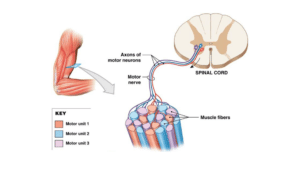
Photo retrieved from https://www.pinterest.ca/pin/360569513914683996/ on June 5, 2022.
As depicted in the photo above as red, blue and purple for easier understanding, these colours essentially represent different types of motor units. Motor units can be divided into three types based on their physiological characteristics.
- Type I Motor Units – typically referred to as slow twitch muscle fibres
- Type IIA Motor Units – typically referred to as fast twitch muscle fibres (or fast twitch type A)
- Type IIB Motor Units – typically also referred to as fast twitch muscle fibres (faster than type IIA)
Type 2a fibres can be thought of as a hybrid fibre between the oxidative qualities of the Type 1 fibres, and the speed qualities of the Type 2b fibres. In other words, they have some endurance qualities and some speed qualities.
When a person decides to make a movement, their motor cortex in their brain sends a signal down the spinal cord, which activates Type 1 muscle fibres first when the contraction is small, and not needing much force. When the muscle force required increases, more and more of the fast Type 2 fibres are activated in order to get more muscle tissue to aid in the contraction (this is essentially the Size Principle for muscle recruitment: Type 1 motor units are smaller and are activated first; Type 2 motor units are larger and are recruited later when more force is required).
To add to the complexity, there are two protective mechanisms built into our muscles, one called a Golgi Tendon Organ (GTO) and the other called a Muscle Spindle (MS).
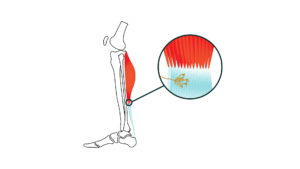
GTO’s (shown above) are located in the tendons (shown in blue and white above). They detect muscular tension when the muscle pulls on the tendon that exists on either end of every muscle, via their location in the tendon. If the tension on the tendon is too great, there is a neural mechanism/pathway in place to cause the opposite muscle to contract, and the same side muscle to relax. Again, this is protective so that the person doesn’t tear their calves, for example, when sprinting maximally. (Of course the mechanism isn’t perfect and doesn’t ensure no tears in any muscles every happen!)
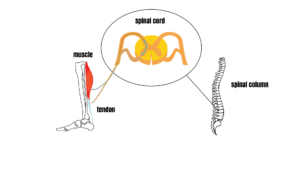
The spinal cord, located within the spinal column, coordinates the messages from the golgi tendon organ in the tendon, with the muscle it attaches to. Simply, too much tension in the calf muscle would send a message to the spinal cord, which would relay a relaxation signal (or negative feedback loop) back to the area to lower tension in that muscle.
By contrast, Muscle Spindles (MS) are located within the muscle belly of each muscle, and detect a stretch in the muscle. If the stretch is too fast or great, the muscle spindles will sense this stretch, relay information back to the spinal cord (similarly to the golgi tendon organ), and relay information back to the muscle for it to contract, to decrease the stretch stress in the area.
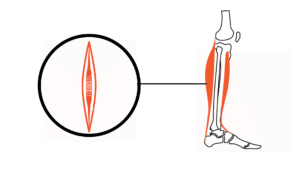
The purpose of a muscle spindles is easily understood via the demonstration in the image below. Have you ever been to a doctor’s office and had the doctor ask you to sit on the edge of the table and relax your leg – then have them tap the tendon below your knee cap to see if you get a knee-jerk reflex? This “tap” causes a quick stretch in the quad, where the muscle spindles (MS) exist. When the stretch occurs, MS’s send information to the spinal cord, which directly synapses back to the muscle to cause the muscle to contract (the kicking of the knee jerk reflex as a response to the tap).
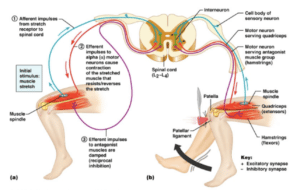
Retrived from McArdle, Katch & Katch (2010).
Zoom back out from the physiology
So how does this relate to the title of this blog – What is the difference between PNF stretching and PAILs/RAILs? What about from traditional stretching? How does all of this relate to each other, and the difference between PNF and PAILS/RAILs style stretching? I’ve summarized them below.

Regular/Passive Stretching
- When most people think of stretching, they think of what I will call “regular stretching”. In other words, relaxing into any joint’s end range until one feels a stretch, and spending some amount of time here
- Many yoga and stretching classes involve a lot of this passive-type stretching
- Passive stretching requires long periods of time to see gains in flexibility (we’ve heard upwards of 10 minutes per position)
- Most people think about dancers or gymnasts doing lots of passive stretching in their practices or before routines. There’s no doubt that with lots of time and dedication, this type of stretching does result in more flexibility
- Most people select passive stretching because it creates “sensation”, is easy, and feels like it is accomplishing something. It can make aches and pains dissipate, so the access level for most people is great and there is a low barrier to entry.
PNF (Proprioceptive Neuromuscular Facilitation)
- Stands for proprioceptive neuromuscular facilitation. This is basically a fancy term for using the muscle physiology to get greater flexibility
- PNF involves stretching the person to their current soft end range and asking them to relax, then getting them to kick against the stretch before relaxing again. As you can see from the image above, the method would be something along the lines of:
- Contract the hamstrings for 3-5 seconds (isometrically – without moving)
- Relax the hamstrings for 5-10 seconds as you pull the hamstrings into a new end range
- Repeat until you don’t see any additional gains in flexibility
The kick/contract of the hamstring in this example turns off the muscle spindle from firing (whose job is to detect too much stretch and make the muscle contract to prevent injury at end ranges). This “turning off” of the muscle spindle reflex allows the hamstrings to lengthen more right after.
The disadvantage to PNF is that it’s mostly passive throughout the stretch (besides the short period of hamstring contraction), but most activities and sports require you to be active throughout a range of motion. For this reason, no strength is built (the definition of mobility is strength/control in a range of motion), therefore it is possible that the gains in range of motion are more transient – and could disappear soon.
PAILS/RAILS (Progressive/Regressive Angular Isometric Loading)
- Stands for progressive and regressive angular isometric loading
- Involves a relax, then push into the stretch (like PNF, to shut off muscle spindles) then a pull into the other range to pull into more ROM. A sample PAILs/RAILs method would be:
- Relax for 10-30 seconds in the same hamstring stretch as shown above
- Contract into the hamstring, exactly the same way you did in the PNF stretching – for 10-30 seconds
- Then use the quads (or in any case – the opposite muscle group) to pull your leg closer to you for 10-30 seconds
- Repeat for a few minutes or until you no longer see additional mobility gains.
The idea here is that because you activate motor units in the end range to create the ROM, you create more strength at the end range that lasts (strength + ROM = superior). Not only do your quads get some “strength” from doing work to pull your hamstrings into a stretch, you also get supposebly more ROM from this method.
Physiologically, there a mechanism in the muscle called reciprocal inhibition, which is the principle that when you contract one muscle group, the opposing muscle group on the other side of the joint needs to relax to allow that motion to occur. So, when you pull the quad into deeper hamstring stretch with the RAILS, you activate this mechanism which is supposed to deactivate hamstrings from contracting. Reciprocal inhibition physiology can be depicted below:
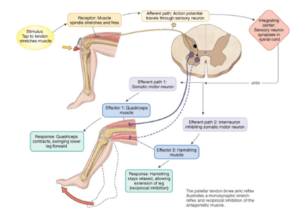
Retrived from McArdle, Katch & Katch (2010).
So, which one to choose?
I find that often in our industry, we like to complicate things with confusing terminology. Recently, we’ve made many posts about these problems specifically:
1st post on bad terminology
https://www.instagram.com/reel/Cc_aRNIKPWV/?igshid=YmMyMTA2M2Y=
2nd post on bad terminology
https://www.instagram.com/reel/Cd3iR5ahcx7/?igshid=YmMyMTA2M2Y=
3rd post on bad terminology
https://www.instagram.com/reel/CeZhcQZoTlz/?igshid=YmMyMTA2M2Y=
How is this related to this blog? Well – I find that which type of stretching you chose for mobility or flexibility improvements for your own clients or self should be simple to understand, simple to use, and require simple protocols. Often, trying to teach an inexperienced person how and when to create tension in the FRC method of PAILs/RAILs is more complicated than it needs to be.
If your client is brand new to training, is doing a take-home program and won’t have your expert help to ensure they are doing things correctly – should you be spending the majority of your precious time with them explaining how to do complicated PAILs/RAILs on many joints? Or, is PNF stretching more simple? Or is regular stretching even more simple than that? There are benefits to all three – so picking your poison according to who is standing in front of you is crucial.
I typically recommend active versus passive options for most of our clients, in most situations. Rehabilitation of injuries should be more active than passive (versus the old-school way of rehabbing which essentially involved bed rest). That being said, I don’t like to start my programming with stretching, and like to keep warm ups active, engaging, and relevant to the session thereafter. Most clients don’t need an anatomy or physiology lesson to help them “open up” some of the key areas prior to their strength or conditioning session.
For this reason, choosing one type of stretching versus the other is extremely individual and will vary from client to client.
How do I implement PAILs/RAILs on other joints?
For resources and explanations on PAILs/RAILs techniques, the best place to go is YouTube, in my opinion. I have found a multitude of videos and ideas on how to set up effective PAILs/RAILs stretches for specific joints, and many videos include a very detailed explanation.
Conclusions
As with most things, prescribing stretching (or loaded stretching, as you’ve learned both PNF and PAILs/RAILs are), should be determined on an individual basis, and trialled and tested over time. Keeping yourself or your client moving well can be achieved in many ways. There. are safe and effective ways of utilizing stretching within programming for athletes (it doesn’t need to be avoided like the plague), and allowing a client who loves to stretch and do yoga to do just that – can increase their activity levels while helping them gain mobility and flexibility that can be lost as we age.
If you found this post helpful, subscribe to our blog below for updates when we release blogs about performance, health, and rehabilitation.

More About The Author
Carla Robbins, Owner of Vital Strength and Physiology Inc
Carla’s journey into the world of endurance training, strength and conditioning, and exercise physiology began with her Undergraduate Degree in Exercise Physiology at the University of Calgary and continued into her graduation with a Master’s in Exercise Physiology in 2016. Between working for the Canadian Sports Institute to the creation of her company Vital Strength and Physiology Inc, Carla is driven by a desire to find better ways to address complex cases in professional and everyday athletes and individuals.
References
Bishop, D. (2003). Warm up I: potential mechanisms and the effects of passive warm up on exercise performance. Sports Medicine (Auckland, N.Z.), 33(6), 439–454.
Chew, M. (n.d.). Permanent Pain Cure – ELDOA: Breakthrough way to heal your muscle and joint pain for good.
Fletcher, I. M. (2010). The effect of different dynamic stretch velocities on jump performance. European Journal of Applied Physiology, 109(3), 491–498. https://doi.org/10.1007/s00421-010-1386-x
Frost, D. M., Beach, T. AC., Callaghan, J. P., McGill, S. (2012). Using the Functional Movement Screentm To Evaluate the Effectiveness of Training. Journal of Streng, 26(6), 1620–1630.
Jansson, E., & Kaijser, L. (1977). Muscle adaptation to extreme endurance training in man. Acta Physiologica Scandinavica, 100(3), 315–24. https://doi.org/10.1111/j.1748-1716.1977.tb05956.x
McArdle, W, Katch, F. I., Katch, V. L. (2015). Exercise Physiology: Nutrition, Energy, and Human Performance. Wolters Kluwer Health/Lippincott Williams & Wilkins
McHugh, M. P., & Cosgrave, C. H. (2010). To stretch or not to stretch: The role of stretching in injury prevention and performance. Scandinavian Journal of Medicine and Science in Sports, 20(2), 169–181. https://doi.org/10.1111/j.1600-0838.2009.01058.x
Page, P. (2012). CURRENT CONCEPTS IN MUSCLE STRETCHING FOR EXERCISE AND REHABILITATION. In The International Journal of Sports Physical Therapy | (Vol. 7, Issue 1).
Power, G. a., Dalton, B. H., & Rice, C. L. (2013). Human neuromuscular structure and function in old age: A brief review. Journal of Sport and Health Science, 2(4), 215–226. https://doi.org/10.1016/j.jshs.2013.07.001
Satariano, W. A., Guralnik, J. M., Jackson, R. J., Marottoli, R. A., Phelan, E. A., & Prohaska, T. R. (2012). Mobility and aging: New directions for public health action. American Journal of Public Health, 102(8), 1508–1515. https://doi.org/10.2105/AJPH.2011.300631
Staley, C. (2001). Physically Incorrect: Charles Staley’s Approach to the Training Sciences.
Wilson, J. M., Flanagan, E. (2008). The Role of Elastic Energy in Activities with High Force and Power Requirements: A Brief Review. Journal of Strength & Conditioning Research, 22(5), 1705–1715.

